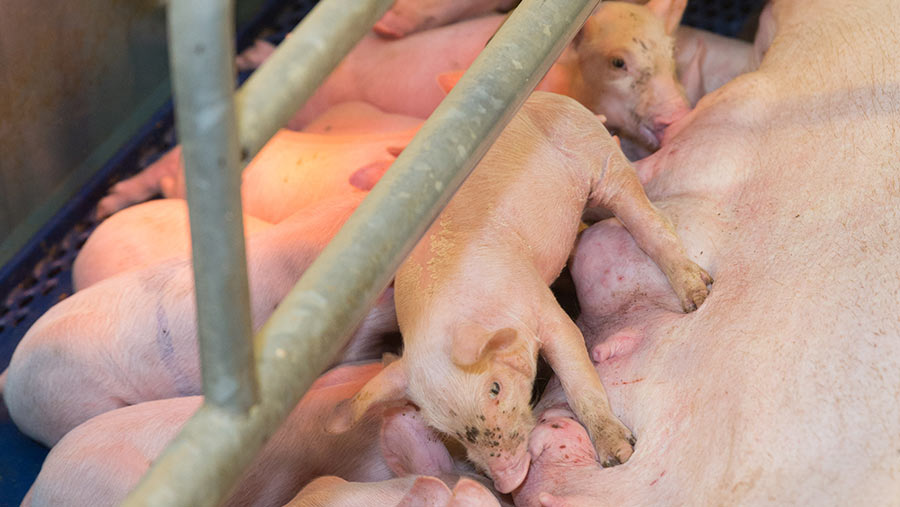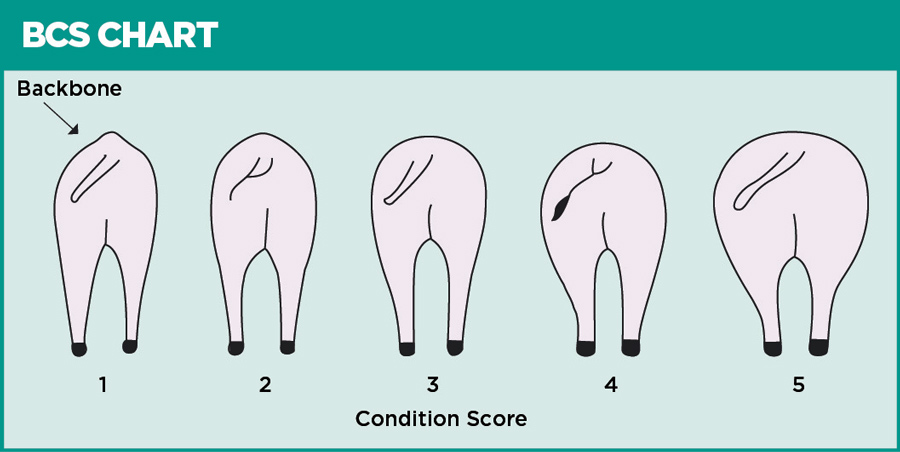Tips for improving piglet survival
 © Tim Scrivener
© Tim Scrivener Within the UK indoor pig herd, the average pre-weaning mortality rate for piglets is 11.68%.
Luchia Gregson from AHDB’s pork knowledge exchange team provides some tips to help piglets and sows thrive and reduce mortality rates.
1. Ensure sows are at the correct body condition score
Prior to farrowing, sows should be at a body condition score (BCS) of 3 to 3.5 (see diagram below). Overconditioned sows are at risk of farrowing difficulties, leg problems and eat less at lactation.
Under-conditioned sows are at risk of low birthweights and poor milk yield.
See also: Tips on improving water quality for pigs
Ideally, farmers should aim for 85% of the herd to be at the correct BCS. This is also a good time to check sows for number of teats and potential nurse sows.

Optimal sow nutrition is essential for a number of reasons, including to:
- Produce a healthy litter.
- Avoid farrowing difficulties.
- Optimise colostrum quality.
- Maximise milk yield.
Diet should be appropriate for the stage of pregnancy. There is no standard amount of feed given before farrowing as this is dependent on the individual and challenges on farm.
In the week before farrowing until one week post lactation (the transition period), a transition diet should be fed.This will prevent constipation and reduce the risk of mastitis, metritis and agalactia problems.
Tips for hitting the correct body condition score
- Regularly body condition score sows during gestation and correct any body condition loss.
- Avoid excessive feeding in gestation (this is expensive and speeds up growth rate).
- Supplement the diet where appropriate.
- Steadily increase feed intake (usually a lactation diet) to meet lactation demands and minimise body condition loss.
- Gilts may require extra nutritional support, talk to your nutritionist for further advice.
- Staff need to be calm and quiet at all times when handling and moving sows.
2. Provide plenty of clean water
The sow must have ad-lib access to good-quality water at a flow rate of 2 litres/minute. Test the flow rate using a 2-litre jug and monitor filling time. Is it full in 60 seconds?
The intake of water increases during lactation, with consumption varying from 12 to 40 litres/day.
If water quality and taste is poor, it can lead to a reduced intake, causing lack of appetite and poor milk production. Where piglets have access to poor-quality water with a high bacterial count, it can expose them to disease and potentially scour.
3. Environment and hygiene
- Immediately after birth, piglets start chilling so keeping the farrowing pen warm and dry.
- The creep area should be kept at 28-32C (and gradually reduced) using a heat source, for example, a heat lamp.
- Farrowing houses should be kept between 20-22C. After farrowing, that can be reduced to 16-18C where covered creeps are used and 18-20C where heat mats are used. Housing also needs to have good insulation and ventilation to prevent heat stress and condition loss.
- If possible, provide nesting material (for example, straw or shredded paper) to increase sow activity and milk let down.
- Provide supplementary heating at the back of the sow when required.
To prevent bug build-up and disease spread:
- Thoroughly clean and disinfect pens (including drinkers and troughs) and any equipment used.
- Use suitable disinfectants and follow instructions for dilution rates.
- Ensure the room is dry and warm before bringing in the next batch of sows.
- Where possible, wash sows down before moving into the farrowing house.
- Clean/change boots and personal protective equipment regularly, especially when moving between different rooms and age groups.
- Provide handwashing stations.
4. Ensure adequate colostrum intake
Colostrum intake has a major influence on piglet survival. It provides nourishment, warmth and immunity (specific to individual farms’ health challenges and vaccination strategy).
Intake of colostrum varies from 200-450g/kg of bodyweight and the following advice will help piglets get their fair share:
- Supervise farrowings – this helps survival chances of the litter.
- Monitor birthing intervals – assist at the appropriate time if delayed.
- Note any stillborn pigs.
- Ensure piglets are not chilling – move to the heat source.
- Guide piglets to the teats (assisted suckling) to speed up the process and stimulate milk let down.
- Identify and mark piglets born early for split suckling.
- After six hours the colostrum quality reduces by a third and the piglets’ ability to absorb antibodies also reduces. Colostrum consumption within six hours of life is essential and should ideally be consumed from their own mother.
- When practising split suckling – removing the first-born and bigger piglets to ensure the smaller ones get colostrum – keep piglets warm when not suckling.
- Where the litter size exceeds the number of teats/milk available, aggression and competition can occur. Methods to even up litters include synchronised farrowings and cross fostering but will be based on your farm policy.
- Cross fostering must be done within 24 hours. Aim to leave a piglet in a litter where there is no excessive competition and a good accessible teat.
- Mark piglets you have fostered. After two-to-three days a “tidy up” maybe required which may involve shunt fostering and nurse sows.
- Delay processing litters, such as injections and castration, for 24 hours to avoid stress and ensure colostrum intakes.
- Piglets need to be handled correctly and quietly at all times.
More information
For further guidance on indoor and outdoor litter management use the following resources:
